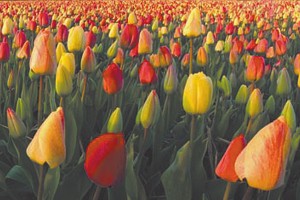October 5, 2011
Yard and Garden: Planting Spring-Flowering Bulbs
 By Richard Jauron
By Richard Jauron
Iowa State University Extension Scott County
To enjoy tulips, daffodils and other spring-flowering bulbs, gardeners must plant them in the fall. The reward for proper planting, once varieties have been selected (there are several thousand daffodil varieties) and bulbs purchased, will be beautiful spring gardens. To have additional questions answered, contact the Iowa State University Extension horticulturists at hortline@iastate.edu or call (515) 294-3108.
When is the best time to plant tulips and daffodils?
October is the ideal time to plant tulips, daffodils and other spring-flowering bulbs in Iowa. When planted in October, spring-flowering bulbs have sufficient time to develop a good root system before the ground freezes in winter. If weather permits, bulbs can be planted as late as mid to late November.
How deep should I plant tulips and daffodils?
Plant spring-flowering bulbs at a depth equal to three to four times their maximum bulb diameter. Accordingly, tulips and daffodils should be planted 6 to 8 inches deep, crocuses and grape hyacinths only 3 to 4 inches deep. Large bulbs, such as tulips and daffodils, should be spaced 4 to 6 inches apart. A 3-inch-spacing is adequate for crocuses, grape hyacinths and other small bulbs.
Plant spring-flowering bulbs in clusters or groups to achieve the greatest visual impact in the garden. When planting daffodils and tulips, plant 10 or more bulbs of the same variety in an area. Smaller growing plants, such as grape hyacinths and crocuses, should be planted in clusters of 50 or more bulbs.
What are suitable planting sites for tulips, daffodils and other spring-flowering bulbs?
Tulips, daffodils, hyacinths, grape hyacinths and crocuses perform best in locations that receive at least six hours of direct sun per day. Siberian squill, snowdrops and snowflakes prefer sites in partial to heavy shade.
Tulips, daffodils and most other spring-flowering bulbs require well-drained soils. Bulb rot may be a problem in poorly drained soils. In poorly drained sites, planting in raised beds is a good option.
How can I keep squirrels from digging up newly planted tulip bulbs?
Several things can be done to make it difficult for squirrels to dig up tulip bulbs. When planting tulips and other spring-flowering bulbs, make sure they are planted at the proper depth. Plant tulips, daffodils and hyacinths 6 to 8 inches deep. Smaller bulbs, such as crocuses and grape hyacinths, should be planted 3 to 4 inches deep. As you place soil over the bulbs, carefully tamp down the soil with your hands or foot. Then water the planting area. Planting the bulbs at the proper depth and firming the soil should make it more difficult for the squirrels to dig up the bulbs. While the aforementioned measures should help, the best way to prevent squirrels from digging up tulips and other bulbs is to cover the planting area with a piece of chicken wire or hardware cloth. Bricks or other heavy objects can be placed on the fencing material to keep it in place. It should be safe to remove the fencing material in winter when the ground freezes.
Are there any spring-flowering bulbs that rabbits and deer won’t eat?
Rabbits and deer are quite fond of tulips and crocuses. However, rabbits and deer seldom bother daffodils, hyacinths, grape hyacinths, Siberian squill and ornamental onions.
Filed Under: Featured
Tags: Crocuses, Daffodil Bulbs, Extension Horticulturists, Grape Hyacinths, Growing Plants, Iastate Edu, Iowa State University, Late November, Plant Spring, Plant Tulips, Planting Daffodils, Planting Spring, Planting Tulips, Richard Jauron, Root System, Snowdrops, Spring Flowering Bulbs, Spring Gardens, Tulips Daffodils, Visual Impact
Trackback URL: https://www.50pluslife.com/2011/10/05/yard-and-garden-planting-spring-flowering-bulbs/trackback/


